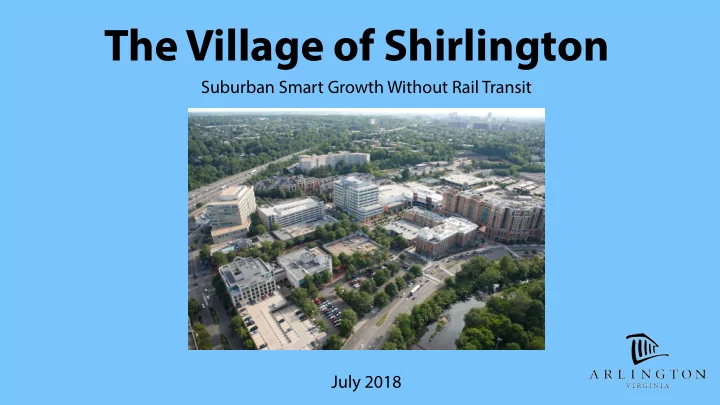

The Village of Shirlington Suburban Smart Growth Without Rail Transit July 2018
Agenda • History (1940 to present) • Attributes and Outcomes • Lessons Learned
Setting the Stage – Arlington County • Arlington is a 26 sq. mi. County, originally established in 1847 • Population of 222,800 and 222,300 jobs • Operates as a unified local government, providing the services of both a city and a county • Located in rapidly growing Washington, D.C. region (6.2 million people)
Shirlington • Located at the south end of the County • 27-acre site adjacent to I-395 (major highway) • Outside Metrorail corridors, but has good bus access • Restaurants and retail at street-level, supported by 1,000 apartments and condominiums, a 142-room hotel and over 500,000 sq. ft. of office space
1940 – 1976: Suburban Shopping Center, from Thriving to Declining • Originally developed by Joe Cherner, a local car dealer • Original goal was to turn the site into an airport, plans were never approved • Shopping center construction began in 1942, completed in 1944 • Shirlington throughout the 1950s • Area began to decline in the mid- 1960s with the opening of Alexandria’s Landmark Shopping Mall
1976 – 1982: Redevelopment Lost • By 1976, Shirlington was suffering decline and was not targeted for Metrorail service • New zoning designations with density incentives were approved • The first Phased Development Site Plan (PDSP) was adopted for the area
1982 – 2000: Redevelopment Started and Stalled • In 1982, the County adopted a new PDSP, laying the foundation for the first major redevelopment of the old shopping center • The 1982 PDSP divided the site into five different proposals • A central change resulting from the PDSP was the creation of a main street for Shirlington: Campbell Avenue
2000 to Today: The Right Plan at the Right Time • The 2000 PDSP took four years to complete, including extensive public review • Retail was reduced by 35%, with increases to residential units (40%) and office development (2%) • This also created a strategy for better integrating Shirlington into the surrounding community by building on characteristics that make the area a unique and special place
Amenities: Design Guidelines • The Shirlington Design Book contains recommendations for public spaces and circulation on guided streetscape development • Developed in conjunction with the 2000 PDSP • Includes graphics and signage, garbage receptacles, bicycle racks, landscaping, fountains, lighting, paving, public art, decorative planters, benches and more
Amenities: Main Street Extension • One of the earliest examples of the County’s participation was its decision to contribute 2.4 acres of its Trade Center site, in order to extend Shirlington’s main street • South 28 th Street was renamed Campbell Avenue and doubled in length • Street design incorporates pedestrian- friendly elements that make the Avenue a comfortable and exciting place for people to walk
Amenities: Library, Theater and Plaza Complex • Previous library was isolated from activity, moved in order to create a civic presence • Signature Theatre was once located in an industrial area, moved in order to increase activity, now reaches over 100,000 people annually • Quarter-acre plaza envisioned as a civic gathering place, includes multiple public art installations
Amenities: Bus Transfer Station • Served by five regional bus routes and two local bus routes • Even before the transfer station opened in 2008, Shirlington was one of the busiest bus hubs in Arlington, with 1,000 daily passenger boardings • Since the station opened, ridership has doubled to more than 2,000 boardings per day
Amenities: Additional Public Parking • In order to achieve the 4,539 parking spaces the PDSP called for, Shirlington had to make the transition from surface parking to structured parking • Negotiation and compromise on parking has been continuous • While Shirlington remains largely car- oriented with five structured parking garages, the emphasis is on shared parking so that visitors only have to park once in order to enjoy all of Shirlington’s amenities
Amenities: Grocery Store • Shirlington lacked a grocery story between the 1980s and mid-2000s • Few grocery chains were willing to adapt their large, suburban stores to the smaller, two-story space that was available • The developer reached an agreement with Harris Teeter, and a 23,000 sq. ft. store was built • Harris Teeter has become critical to Shirlington’s success as a residential center
Amenities – Conclusion • Between 2000 and 2010, the Shirlington PDSP was completely implemented • Fortunately, the plan was amended prior to a development boom • Had the plans not been in place, the area would have missed a significant opportunity to revitalize • Today, Shirlington is a thriving, mixed-use urban village in its own right, but at a different scale than smart-growth communities within rail transit corridors
Lessons Learned – Planning • First iterations of plans are not always successful It took an entire generation to • transform Shirlington into the vibrant urban village it is today • Success requires creativity, in addition to increased density Excluded density provided the library, • theater and plaza complex • Support a mix of uses that are sustainable in the local market
Lessons Learned – Partnering • Strong and innovative public- private partnerships facilitate development Both Arlington County and Federal • Realty were highly motivated to turn Shirlington into a community asset • Tie investment to specific attributes and outcomes, giving investors some degree of certainty By creating detailed streetscape and • building guidelines, as well as building new infrastructure, investors have a clearer idea of the end result
Lessons Learned – Engaging • Engaging residents is the key to creating successful, contextual plans that build on the community’s assets Neighboring communities provided • input throughout planning process at over 50 meetings leading up to the adoption of the plan • Proactively address community concerns Concerns raised about increased traffic • Developer was required to contribute • $200,000 to be used for traffic-calming measures in neighborhoods
Thank You! Arlington County Planning Division CPHD@arlingtonva.us 703-228-3525
Recommend
More recommend